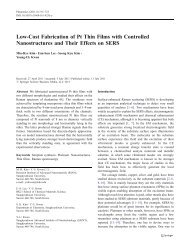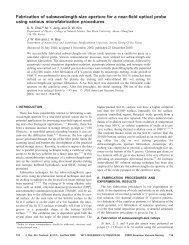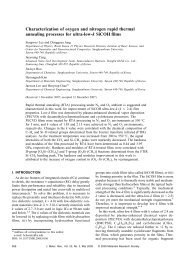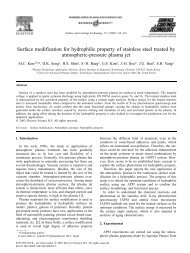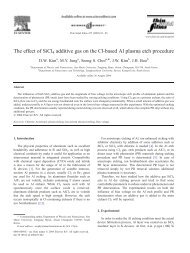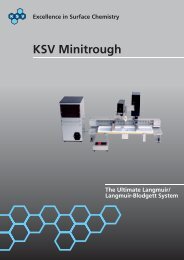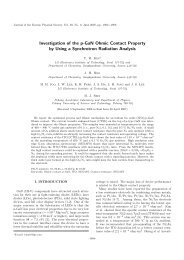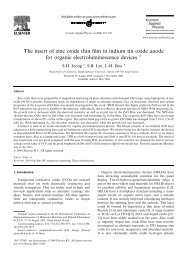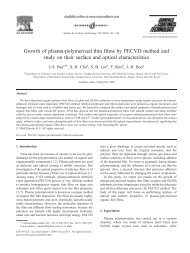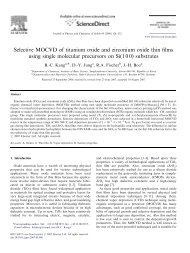A Versatile Surface Modification Scheme for Attaching Metal ...
A Versatile Surface Modification Scheme for Attaching Metal ...
A Versatile Surface Modification Scheme for Attaching Metal ...
Create successful ePaper yourself
Turn your PDF publications into a flip-book with our unique Google optimized e-Paper software.
<strong>Attaching</strong> <strong>Metal</strong> Nanoparticles onto Gold J. Phys. Chem. B, Vol. 106, No. 34, 2002 8669Figure 3. (A) Typical electrochemical IRAS spectra (in ν CO region)at -0.25 V vs SCE in 0.05 M H 2SO 4 <strong>for</strong> saturated CO adlayers <strong>for</strong>medon Pt-coated Au, Pt black, and 1:1 Pt/Ru alloy (d ≈ 2.5 nm) filmsattached to gold as in Figure 1. (B) Comparison of IRAS spectra (at-0.25 V) <strong>for</strong> C/Pt (d ≈ 8.8 nm) film physically adsorbed on bare Ausubstrate, and attached by using present MPTS film.rates than <strong>for</strong> the latter reversible reaction, 15 enables unambiguousmeasurement of electrode kinetics even when using slowlinear sweep voltammetry. 15-17 ) Briefly, the Ru(NH 3 )3+/2+ 6couple (<strong>for</strong>mal potential -0.18 V vs SCE) exhibited essentiallyreversible voltammetric behavior, at least <strong>for</strong> scan rates below1Vs -1 , on the 3-MPTS modified surface both in the absenceand presence of the nanoparticles. The irreversible voltammetricwave <strong>for</strong> Co(NH 3 )3+ 6 reduction was shifted to higher overpotentials,from ca. -0.2 to -0.4 V vs SCE, in the presence ofthe 3-MPTS film, indicating a substantial (ca. 10 3 fold)attenuation of the electron-transfer rates, essentially in accordancewith the electron-transmission properties of relatedalkanethiol films on gold electrodes. 18.19 However, the additionof Au nanoparticles decreased the overpotential by ca. 0.1 V(i.e., increased the rate by 10-fold or so). Overall, thesecharacteristics are sufficiently favorable to endow the nanoparticlefilms with reasonable electroactivity <strong>for</strong> electrocatalyticpurposes.Of central interest here are the in-situ IRAS properties ofadsorbates on these and other nanoparticle electrode films.Figure 3A,B shows typical spectra obtained <strong>for</strong> saturated COadlayers <strong>for</strong>med on various Pt nanoparticles. Each spectrumrefers to -0.25Vin0.05MH 2 SO 4 (with CO removed fromsolution prior to the measurement). The reference spectrum(obtained to subtract out solution and other spectral interferences)was acquired after stepping to 0.65 V to electrooxidativelyremove the adsorbate. 20 Figure 3A compares spectra inthe C-O stretching (ν CO ) region <strong>for</strong> Pt-coated Au, Pt black (videsupra), and 1:1 Pt/Ru alloy particles (d ≈ 2.5 nm), as noted. Ineach case, a well-defined atop ν CO feature is evident at 2035-2060 cm -1 . (The ν CO redshift observed <strong>for</strong> the Pt/Ru particle isconsistent with the presence of a surface alloy. 21 ) The dependenceof the ν CO frequency on the electrode potential E (theso-called Stark-tuning slope, dν CO /dE), typically 30-35 cm -1V -1 , is essentially the same as obtained <strong>for</strong> conventional Ptelectrodes. 6 Significantly, this confirms that the electrodepotential of the nanoparticles varies in tandem with that <strong>for</strong> theunderlying metal substrate, further supporting the occurrenceof electronic equilibration [point (a) above].Figure 3B shows a comparison between the ν CO spectraobtained <strong>for</strong> a C/Pt film deposited physically onto a bare goldelectrode (as in refs 6,8) with that <strong>for</strong> the same material attachedonto the MPTS-modified gold surface (upper, lower spectra,respectively). The ν CO peak absorbance and band shape towardFigure 4. Comparison of potential-difference infrared spectra obtained<strong>for</strong> saturated CO adlayers on planar (polycrystalline) Pt, C/Pt nanoparticlefilm physically deposited on bare Au, and C/Pt film attachedto MPTS-modified Au, with intensity (absorbance) scales adjusted soto yield the same 2345 cm -1 band intensity (arising from CO 2electrooxidation).lower wavenumbers are very similar on the two substrates.However, an important difference is that the “anomalous”negative-going ν CO peak observed on the high-wavenumber sideof the top spectrum is entirely absent <strong>for</strong> the nanoparticles boundon the 3-MPTS modified surface. As already mentioned, such“anti-absorbance” ν CO band components are often observed inaggregated metal nanoparticle films, 8,11 associated with theircomplex dielectric behavior, which can obfuscate the IRAS datainterpretation.Another welcome property of the present nanoparticle filmsurfaces is the observation of infrared cross sections <strong>for</strong>chemisorbates that are significantly (10-fold or more) larger thanon chemically similar, yet macroscopically planar, metalsubstrates. The measurement of such infrared “enhancementfactors”, EF, is readily undertaken <strong>for</strong> irreversibly adsorbed COon electrodes by comparing the integrated absorbance <strong>for</strong> theν CO band(s), A(CO), with that <strong>for</strong> the corresponding 2345 cm -1band <strong>for</strong> CO 2 , A(CO 2 ), <strong>for</strong>med upon CO electrooxidation. 6[Since A(CO 2 ) is proportional to the number of adsorbedmolecules (<strong>for</strong> a given spectral thin-layer configuration),comparison of the A(CO)/A(CO 2 ) ratios <strong>for</strong> nanoparticle filmelectrodes with that <strong>for</strong> a “reference planar” surface enables EFestimates to be determined <strong>for</strong> the <strong>for</strong>mer.] Potential-differencespectra illustrating this procedure are shown in Figure 4, wherethe intensity scale is adjusted so that the 2345 cm -1 bandamplitude is identical: the ν CO band intensities then yielddirectly the relative EF values. The IRAS data in Figure 4 are<strong>for</strong> saturated CO adlayers <strong>for</strong>med on three surfaces: planar(polycrystalline) Pt, a multilayer C/Pt film on bare gold (cf.,ref 8), and a monolayer-level C/Pt film on MPTS-modified gold.The marked infrared enhancement (EF ≈ 15) <strong>for</strong> the last filmwith respect to planar Pt is clearly evident, as is the larger EFvalue in comparison with that <strong>for</strong> the C/Pt film on unmodifiedgold. Evidently, then the present procedure yields IRAS datadisplaying high analytical sensitivity (i.e., substantial EF values)as well as lack of anomalous “anti-absorbance” features.Concluding RemarksOverall, the use of MPTS-modified gold surfaces provides aversatile route <strong>for</strong> preparing monolayer-level films of metalnanoparticles exhibiting near-ideal IRAS as well as electrochemicalproperties. This strategy should also prove useful <strong>for</strong>



